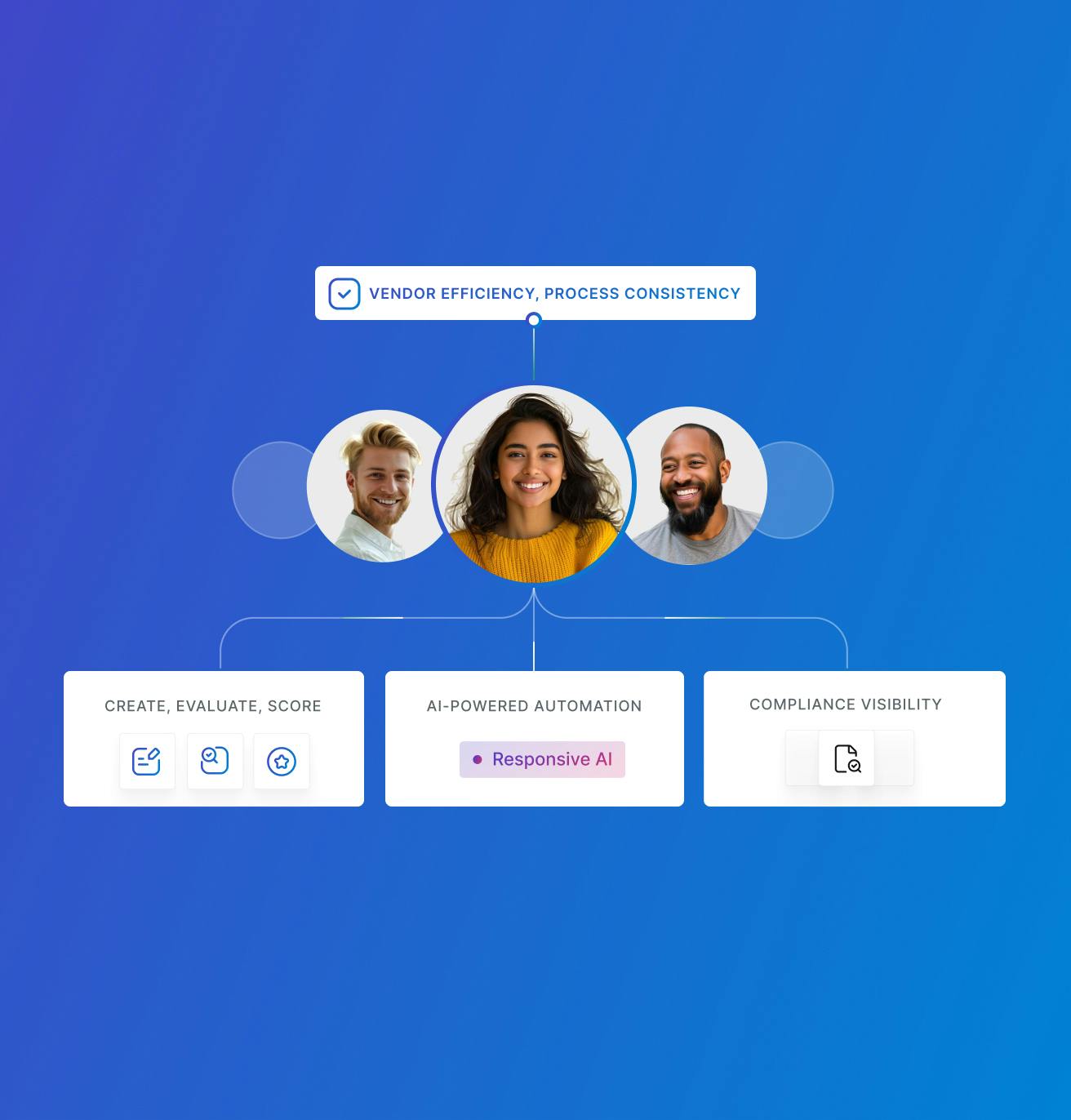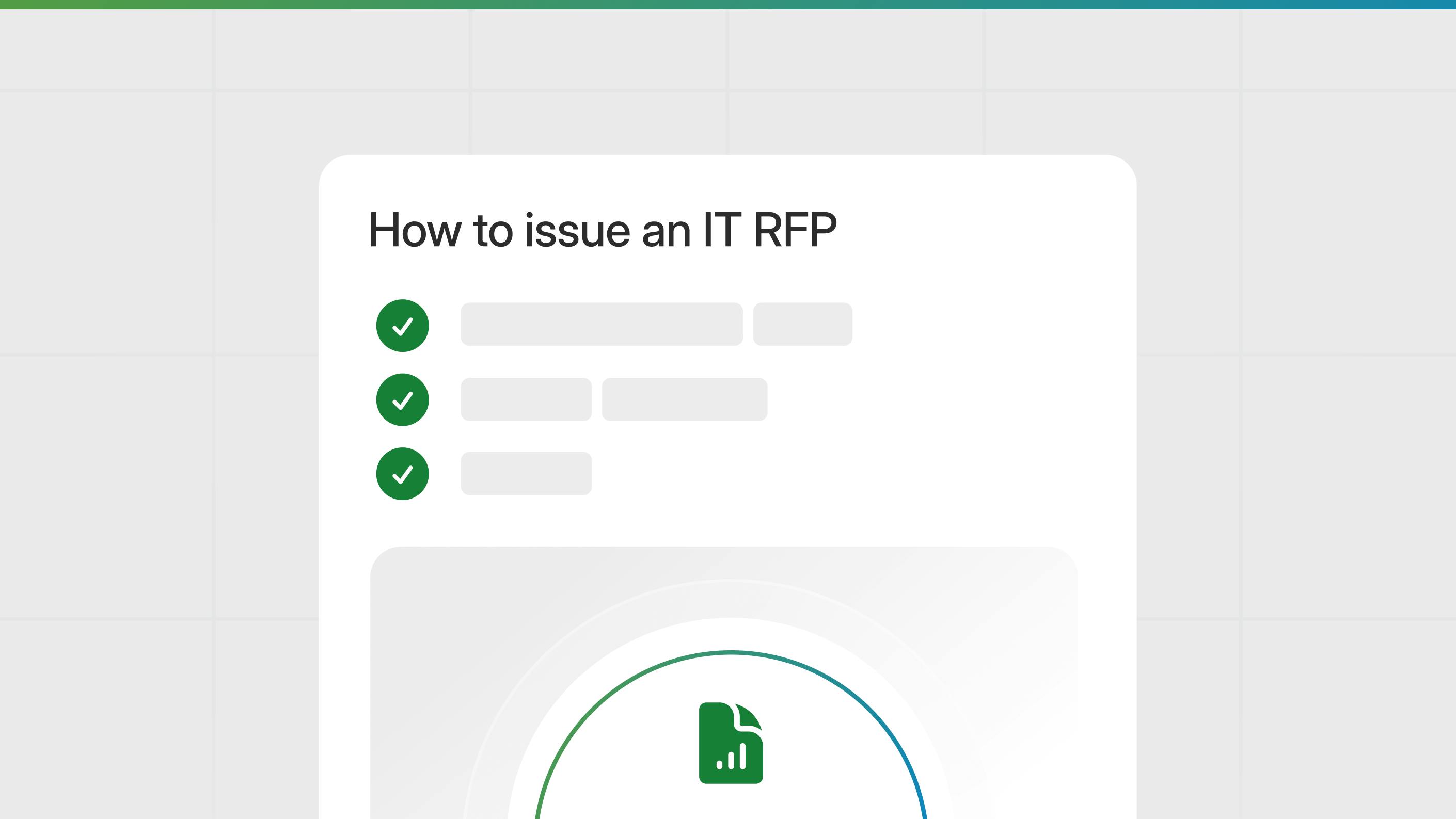Investing in an IT service or product is a high-stakes decision. It’s often a significant spend with big expectations, and choosing the wrong vendor can carry serious risks. From data security to implementation timelines to industry fit, there’s a lot to evaluate. A well-crafted IT RFP can bring clarity, structure, and confidence to your decision.
In this guide, we’ll walk you through how to create an effective IT RFP. You’ll learn the essential terminology, step-by-step guidance for sourcing the right vendor, and get access to real-world examples and a ready-to-use template.
Key IT sourcing terminology
Before we jump into how to write an IT RFP, let’s go over some key definitions and terminology often used for technology procurement.
What is IT sourcing?
IT sourcing is the process of selecting an external information technology solution. The strategic sourcing process evaluates an IT solution’s usability, technical capabilities, security, and customer resources.
McKinsey Technology describes the importance of strategic IT sourcing saying:
“IT sourcing teams are expected to balance between controlling technology run costs and risks while simultaneously building strategic technology partnerships. They are required to create a wide range of win–win external partnerships to access state-of-the-art software and solutions—such as cloud, machine learning, and advanced analytics—acquire global talent, enable agile processes, and procure innovative services.”
ROI
Return on investment (ROI) is the value delivered by a solution. Throughout the information technology RFP process, ROI should be a top priority. Consequently, vendors that also focus on your ROI are more likely to deliver it.
RFI
An IT request for information (RFI) explores the market. When faced with a challenge, an IT RFI presents the problem and asks for vendors to offer their best solution. Generally, creative and innovative proposals are welcome. The RFI doesn’t necessarily lead to a future purchase, but it can inform your solution planning and RFP creation.
RFP
An information technology request for proposal (RFP) is more formal than an RFI and asks specific questions. Generally, the RFP will also include background information about the problem and how the business expects vendors to meet their needs. When an vendor receives an RFP, it indicates that a purchase is imminent. Certainly, the questions in the RFP should reflect the company’s priorities.
Common IT RFP questions may include:
- Technical and functional requirements
- Client references
- Customer success and support
- Onboarding and training process and timeline
- Data security and service level agreements
- Pricing models, including any user and data limits
Security questionnaire
A security questionnaire is a document used to evaluate a vendor’s security policies and practices. Its purpose is to build trust between a customer and an IT vendor. Also known as a third-party risk assessment, vendor risk assessment, or SIG questionnaire, it’s a key part of the software and technology procurement process. In addition to being required during initial sourcing, it’s often reissued annually to confirm ongoing compliance.
A security questionnaire covers:
- Security audits and penetration testing
- Internal security practices and policies
- Personnel policies, hiring practices and training programs
- Security certifications
- SLAs and uptime vs. downtime
- Web application security
- Physical and datacenter security
- Infrastructure security
- Business continuity
For a full procurement glossary, check out this blog post: RFP and RFx definitions: A procurement glossary from A-Z.
The RFP Resource Hub
3 simple steps for creating effective IT RFPs
1. Clarify your goals, and choose the right request type
Before issuing a technology RFP, be clear on what you're trying to achieve. RFPs are formal and time-consuming, best used when you're ready to buy, have defined goals, and are open to vendor input on how to solve the problem.
If you're just looking for pricing, use an RFQ. If you're exploring options without a firm intent to buy, an RFI may be more appropriate.
If you move forward with an RFP, keep it focused. Use multiple rounds if needed, and ask deal-breaker questions upfront to quickly narrow the field, and save time for you and your vendors.
2. Learn from others' IT RFPs
Don’t start from scratch. Use templates and study how other organizations have structured similar technology RFPs. This can give you a strong starting point and help you spot gaps in your own requirements.
IT RFP insights from healthcare
There’s a lot of great information available about IT sourcing in specific industries. Luckily much of it can be applied to almost any industry. For example, below are some of our favorite bits of wisdom from the healthcare industry.
“Identify and gather the need for your organization or a specific project that requires an external solution. During this planning, stakeholders are involved in defining project scope and objectives. Set a clear goal of work, project timeline, and budget for the entire project. It determines how medical proposals are evaluated.” — Request for Proposal (RFP) Template for Healthcare IT Projects
“It is important to remember that the purpose of selecting a vendor and developing a solution is to provide the end users with technical capabilities that solve a business issue. The RFP should focus on these capability requirements.” — 4 Best Practices for a Successful Healthcare IT RFP Process
3. Cover the essentials in your RFP
Once you’ve seen some examples of similar RFPs and gathered the product and service-specific criteria, you’re ready to write your RFP.
Remember to:
- Clarify your organization’s storage standards for on-premise vs. cloud storage
- Identify your security requirements
- Read vendor case studies. Do the testimonials demonstrate how they can solve your challenges?
- Research how vendors provide customer service. For example, is it automated or only available during certain hours?
- Look at the vendor’s competitors. If you can’t tell who they are, feel free to ask them directly.
- Read vendor ratings on websites like Capterra and G2

An overview of the RFP for IT services process
Strategic sourcing for IT solutions should be a multi-step process, rather than a single step of just issuing your IT RFP. Admittedly, not all of the steps listed below are required for a successful project, certainly they can all be helpful.
- Identify your business challenge
Collaborate with stakeholders and internal teams to define the problem they’re facing. Ask for suggestions about what the ideal solution would look like. Begin gathering requirements, background, goals and needs. Some organizations us a business requirements document or functional requirements document to organize their needs. - Explore your options
Issue an RFI to explore the market. Consider casting a wide net for this step to ensure you have a solid understanding of all available options. - Create and issue your RFP
Be sure to include background information, the goals you established, your implementation timeline and a request for references. - Proposal evaluation
Compare vendors and evaluate responses. Be sure to involve stakeholders with relevant expertise. Remember, weighted scoring can make your choices much more clear. - Select your shortlist vendors
Use your scoring results to select your shortlist. Don’t forget to consider ability to execute, their track record of success and ability to scale. - Security questionnaire
While some businesses prefer to send the security questionnaire with the RFP, consider sending it after you’ve selected your shortlist to avoid asking vendors who aren’t a fit to do unnecessary work. - Request demonstrations
Now that you’ve selected your shortlist and verified their security is sufficient, it’s time to see it in action. So, schedule your RFP presentations. - Final vendor selection
Hopefully at this point, you have a clear idea of who the best choice is. Using the RFP, build a contract and set your plans for implementation.
IT services RFPs are like any other. So, it’s important to follow RFP best practices when creating them.
IT RFP examples and templates
CRDF Global is a nonprofit organization with an IT Director and two software developers. So, when they needed general IT support, they issued this thoughtful RFP for IT services that offered excellent background information, clear evaluation criteria and required services. It’s a great example of an effective IT RFP.
Technology RFP example |eProcurement Solution and Implementation Services
This RFP from the State of Vermont details the agency’s need to streamline the procurement process for their education system. In addition to the RFP for technology and professional services example, you’ll also find a sample bidder form and additional information here.
This information technology request for proposal template is a Word document provided by DP Solutions, an IT service provider. If you ask, many vendors will happily provide you with an RFP for technology template to use. However, if you use one of these templates, remember to customize it, and ensure that your final RFP isn’t biased to favor the company who provided the template.
State of North Carolina information technology RFI template
The State of North Carolina’s information technology department offers a catalog of useful templates and reference materials. Their documents include an IT RFI template that can easily be adapted for use by any organization.
Final thoughts on RFPs for IT services
Key takeaway: Remember, make sure your RFP will actually achieve your objective. Consider that there might be a simpler, quicker way to find the information you need (RFQ, RFI, etc.). Finally, if you do go with an RFP, do your homework, look for tips and examples, and make sure you’ve included all the critical criteria.
